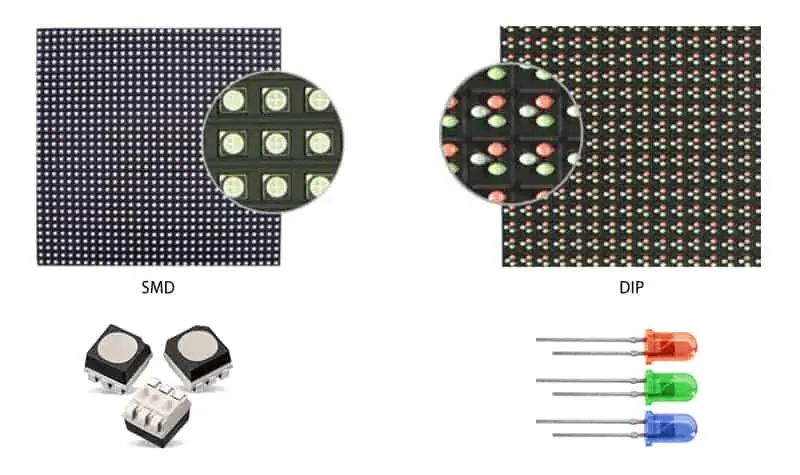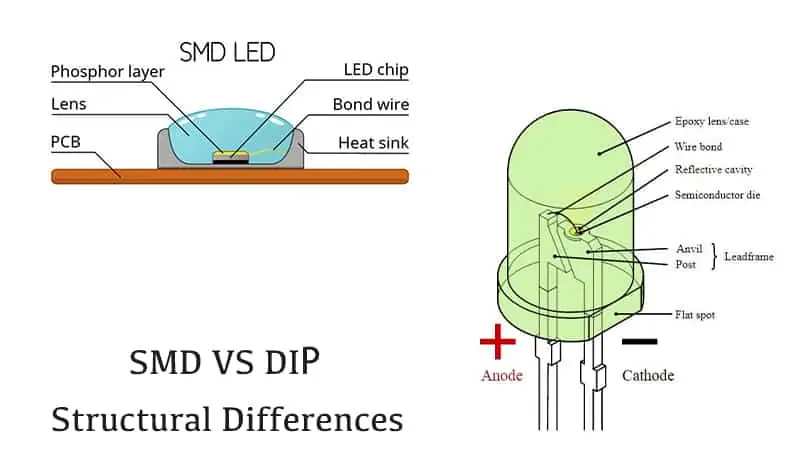What is DIP technology?
DIP meaning (Dual In-line Package)
Dual in-line package is an electronic component package with a rectangular housing and two parallel rows of electrical connecting pins. The package is through-hole mounted to a printed circuit board (PCB) or inserted in a socket. DIP screens have a separate LED (R, G, B) for each of the three main colors: Red, Green, and Blue.
Now being used in just about every lighting situation pertaining to technology, they are most recognized by the two pins that extend from the bottom of the LED.
What is SMD technology?
SMD meaning (Surface Mounted Devices)
Surface-mount technology (SMT) is a method for producing electronic circuits in which the components are mounted or placed directly onto the surface of printed circuit boards (PCBs). An electronic device so made is called a surface-mount device (SMD).
SMD’s came about due to devices becoming smaller and the need to be able to have this type of LED fit within the smaller technology. So with that said, the uses for SMDs have rapidly increased in the first decade of the 21st century.
DIP LED screen is one of the old designs of LED if compared with the new technology of SMD. But it is also one of the most durable and stable solution for outdoor led display. SMD led display is an new technology these years and it becomes more and more popular now due to its better picture quality and higher resolution.
Following is a photo showing the DIP and SMD LEDs for your reference.
Advantages of DIP and disadvantages of SMD
- For DIP that each pixel is made of three independent color(RGB) LED bulbs. Each bulb have two long feet. The long feet are inserted into PCB pad, so after through-hole soldering that there will be seldom cold soldering problem. The SMD LED display has short feet and the led lamp was mounted on the PCB pad which is more easier to cause cold soldering problem than the DIP one.
- The long feet enable the led bulbs do better performance on heating dissipation. Better heating dissipation means long life time for led displays. So DIP LEDs would be more durable than SMD one from long run.
- The DIP LED lamp size is big, it allows the led screens present higher brightness. Usually normal brightness DIP led displays can reach 7,500nits while the high brightness one can reach more than 10,000nits. Normally for outdoor SMD led display that the brightness is around 6,000nits.
- DIP led screens consume less power if compared with same specifications SMD. Usually the power consumption of DIP LED displays is 1/3 less than the SMD one.
Compared to DIP displays, SMD displays have the following advantages:
- SMD’s are light weight, they have a much wider visual angle, the color output is much crisper and truer to the intended color along with better color uniformity They are more energy efficient then the DIP.
- SMD chips that features better heat dispersion, high lumen output (high lumen flux ) and longer overall life (low optical decay) than its predecessor the DIP LED .
- SMD’s having a much more natural look and feel of an image on an LED Display – being much less pixilated.
- SMD’s is that they can be easily manufactured using efficient quantity mass production, which helps keep the costs down during production. This will obviously save on labor costs and LED Displays will be able to have a larger scale of production.
In general that they both have advantages and disadvantages. If your outdoor fixed installation project requires high brightness and more durable application then you may choose DIP LED displays.
If you require higher resolution and wider viewing angle then SMD LED would be a good option. For indoor application, the viewing distance is shorter and usually we seek for the best picture quality and no need very high brightness, so the SMD led screens would always be the best option.


